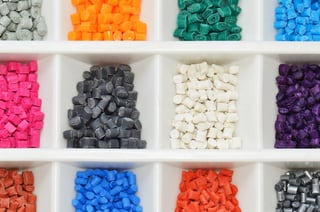We recently wrote about the differences between Nylon 6 and Nylon 6,6. Now we want to discuss the differences between Nylon 4,6, Nylon 11, and Nylon 12 and differentiating them from Nylon 6 and Nylon 6,6.
As we discussed in the previous blog in this nylon series, nylons are semi-crystalline resins with a very low viscosity at melting point, excellent chemical resistance, good temperature resistance, and good toughness (moisture). There are 8 types of nylons: Nylon 6; Nylon 6,6; Nylon 4,6; Nylon 6,9; Nylon 6,10; Nylon 6,12; Nylon 11; and Nylon 12.
Nylon 4,6
Nylon 4,6 has a higher melting point, faster crystallinity, quicker cycles, and a higher impact; but it also has higher moisture absorption, is a higher price, and higher specific gravity.
The chemical structure based on properties compared to Nylon 6 and Nylon 6,6 is shown in this table below.
|
Nylon 6 |
Nylon 6,6 |
Nylon 4,6 |
|
|
Melting Point C |
220 |
260 |
295 |
|
Sp Gravity |
1.14 |
1.14 |
1.18 |
|
Crystallization Rate |
0.2 0.0 |
6.0 0.7 |
>15 |
|
Moisture Abs |
2.8 |
2.5 |
3.8 |
The thermal properties of unreinforced polyamides compared to Nylon 6 and Nylon 6,6 are shown below in the table.
|
Nylon 6 |
Nylon 6,6 |
Nylon 4,6 |
|
|
Crystalline Melting Point C |
225 |
260 |
295 |
|
Heat Deflect Temp. C |
65 |
75 |
160 |
|
Relative Thermal Index C electrical |
130 |
130 |
150 |
|
Mechanical without impact |
85 |
85 |
130 |
|
Mechanical with impact |
70 |
75 |
115 |
|
Nylon 6 |
Nylon 6,6 |
Nylon 4,6 |
|
|
Strength/Stiff |
2 |
2 |
1 |
|
Tough/Ductility |
2 |
3 |
1 |
|
Aesthetics |
1 |
3 |
3 |
|
Processability |
1 |
2 |
3 |
|
Cycle Time |
3 |
2 |
1 |
|
Material Cost |
1 |
2 |
3 |
|
1=BEST |
2=Better |
3=Good |
Nylon 11 & Nylon 12
Both Nylon 11 and Nylon 12 are linear, semi-crystalline thermoplastics which could be intermediate in properties between Nylon 6 and polyethylene. Nylon 11 is derived from castor oils and Nylon 12 comes from butadiene. Nylon 12 has a slightly lower melting point and density and Nylon 12 performs better at high temperatures and has superior UV resistance.

Nylon 11 and Nylon 12 vs. Nylon 6,6
Their advantages include low moisture absorption (.25% vs. 2.5%) and excellent flexibility: where Nylon 6,6 would be too rigid, they would sometimes be used in wire and cable applications instead. However, they have a low HDT of 300 F, low tensile at 8,000 psi, low dielectric strength, and are a higher cost.
PA 6,9; PA 6,10; PA 6,12; PA 11; PA 12
Advantages:
- Good elongation
- Lower moisture absorption
- Good electrical
- Lower specific gravity
Disadvantages
- Lower physical and mechanical properties
- High cost
In comparison:
|
6,6 |
6 |
6,9 |
6,10 |
6,12 |
11 |
12 |
|
|
HDT |
374 |
365 |
340 |
330 |
330 |
300 |
300 |
|
Tensile |
12,000 |
12,000 |
8,500 |
lower 6,6 |
8,800 |
8,000 |
8,000 |
|
Moisture Absorption |
2.5% |
2.8% |
1.5% |
1.5% |
0.25% |
0.25% |
|
|
Elongation |
25% |
25% |
Good |
200% |
250% |


